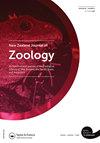水和动物粪便中的微生物多样性:评估公共卫生风险的宏基因组分析
IF 1.1
4区 生物学
Q3 ZOOLOGY
引用次数: 6
摘要
环境DNA (Environmental DNA, eDNA)为研究与粪便污染相关的水体微生物群落变化提供了新的途径。饮用水中的粪便可能含有病原体,从而导致严重的水传播疾病。因此,饮用水需要有关来自不同来源的粪便污染的微生物多样性的综合信息,以降低胃肠道疾病的风险。在这里,我们调查了新西兰15个休闲露营地的水和粪便样本的微生物多样性。采用16S rRNA元条形码技术分析了42份粪便(2只兔子、7只鸭子、7只反刍动物、7只雀形目动物、9只负鼠和10只白狐)和75份水(37份取水和38份取水)样本。我们的研究结果表明,水样比粪便具有更高的微生物多样性。细菌群落的典型对应分析和识别病原体的NeighborNet树显示来自相似来源的样本聚类。系统发育分析表明,水体中存在Arcobacter和Sulfurospirillum以及指示生物Escherichia和enterococci,而弯曲杆菌主要存在于粪便中。这些发现为了解饮用水质量提供了新的见解,并允许未来用于识别水中的粪便污染。本文章由计算机程序翻译,如有差异,请以英文原文为准。
Microbial diversity in water and animal faeces: a metagenomic analysis to assess public health risk
ABSTRACT Environmental DNA (eDNA) offers a new avenue for investigating changes in the water microbial community associated with faecal contamination. Faeces in drinking water might include pathogens, which result in serious waterborne diseases in humans. Therefore, drinking water requires comprehensive information about microbial diversity that comes from faecal contamination of different sources to reduce the risk of gastrointestinal diseases. Here, we investigated the microbial diversity of water and faecal samples at 15 recreational campgrounds in New Zealand. In total, 42 faecal (two rabbits, seven ducks, seven ruminants, seven passerines, nine possum and ten Pukeko) and 75 water (37 intakes and 38 taps) samples were analysed using 16S rRNA metabarcoding. Our results suggested that water samples harbour a higher microbial diversity than faeces. Canonical correspondence analysis of bacterial communities and NeighborNet tree of recognised pathogens showed clustering of samples from similar sources. Phylogenetic analyses showed evidence for the presence of Arcobacter and Sulfurospirillum and indicator organisms Escherichia and enterococci in water, while Campylobacter was mainly found in faeces. These findings provide novel insights toward understanding the quality of drinking water and allow future use for the identification of faecal contamination in water.
求助全文
通过发布文献求助,成功后即可免费获取论文全文。
去求助
来源期刊
CiteScore
2.80
自引率
0.00%
发文量
20
审稿时长
>12 weeks
期刊介绍:
Aims: The diversity of the fauna of the southern continents and oceans is of worldwide interest to researchers in universities, museums, and other centres. The New Zealand Journal of Zoology plays an important role in disseminating information on field-based, experimental, and theoretical research on the zoology of the region.

 求助内容:
求助内容: 应助结果提醒方式:
应助结果提醒方式:


